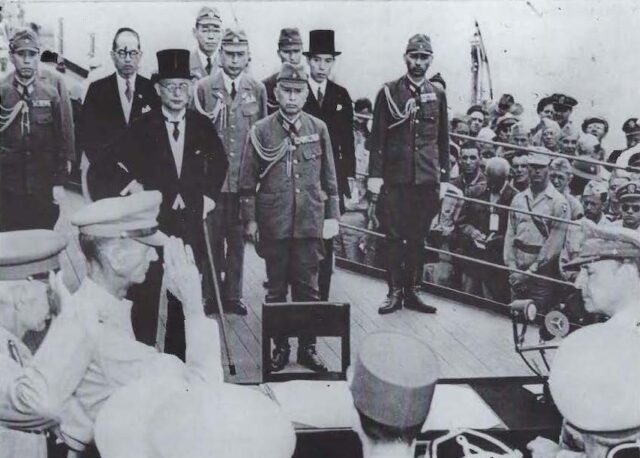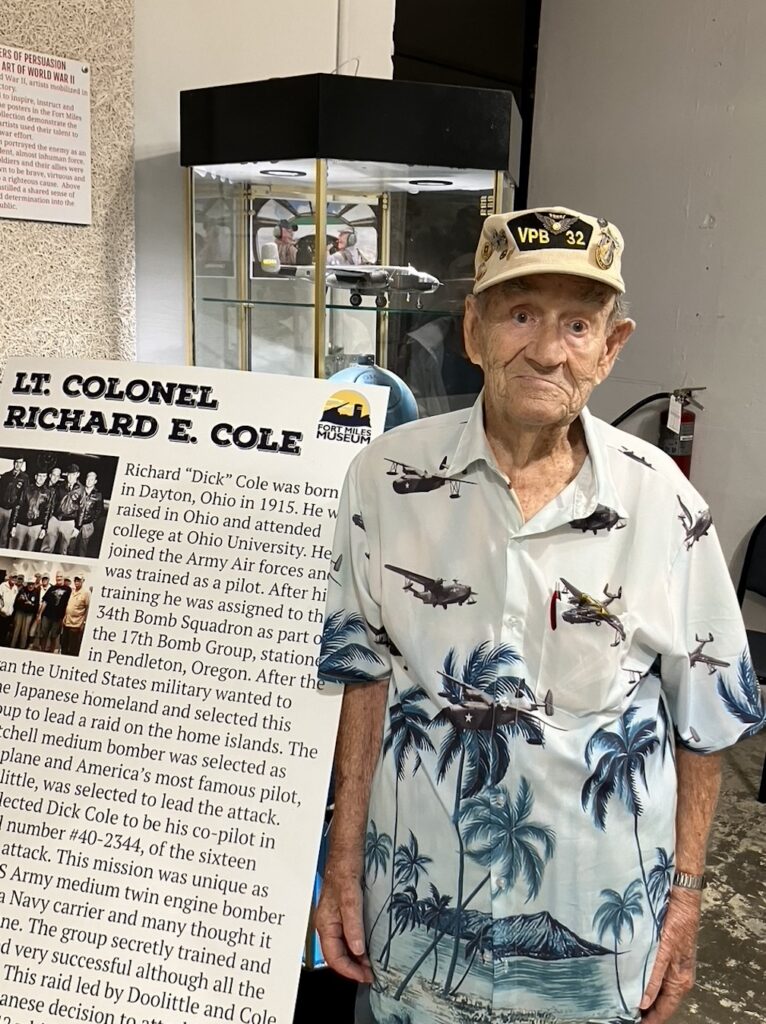
Source: DE Tourism
September 2nd VJ-Day Ceremony at Fort Miles – Honoring Delawareans and a Tribute to WWII Navy Veteran AMMF 3/C John Reichert
World War II was the deadliest military conflict in history. It began with the Nazi invasion of Poland in 1939. The United States entered the war in 1941 after the Japanese invasion of Pearl Harbor on December 7. The war ended in 1945 following the German surrender in May and the Japanese surrender in September. Worldwide, an estimated total of 70-85 million military personnel and civilians perished during the war. Most deaths were a direct result of military engagement, but many died from war-related disease and starvation. United States casualties included 419,400 civilian and military personnel killed in action and another 671,801 wounded.
On the morning of September 2, 1945, nearly four years after the Japanese attack on Pearl Harbor, the Allied and Japanese delegations met aboard the battleship USS Missouri in Tokyo Bay for the formal signing of the surrender documents, thereby ending World II. After finishing an eloquent introductory statement, General Douglas MacArthur directed the representatives of Japan to sign the two instruments of surrender, one each for the Allied and Japanese governments. They were followed by representatives of the United States, China, the United Kingdom, the Soviet Union, Australia, Canada, France, the Netherlands, and New Zealand. As the surrender ceremonies concluded, 450 carrier planes from the U.S. Navy’s Third Fleet passed in massed formation over the Missouri. A few minutes later, Army Air Forces B-29 bombers flew by. This noisily impressive demonstration underscored the power that had brought Japan and the Allies to this time and place.

On September 2nd, 2024, at 9:00 AM, the Fort Miles Historical Association will conduct its eighth Victory over Japan ceremony outside the Fort Miles Museum under the shadow of its USS Missouri gun display. This annual ceremony at Fort Miles, in Cape Henlopen State Park, celebrates the official end to World War II and honors the 774 Delaware members of the Armed Forces and Merchant Marines who died while serving their country during that war. The ceremony includes an account of the day of the surrender as well as a reading of General MacArthur’s speech. Near the conclusion of the ceremony, FMHA volunteers read the names of 50 of those Delawareans while tolling a ships bell after each name is read. Each of this year’s 50 honoree’s name, rank, branch of service, and hometown is read as well as the date and location of his passing.
This year’s ceremony also will feature a tribute to John A. Reichert, who was a United States Navy Aviation Machinist’s Mate and Flight Engineer during World War II. John was born on October 28, 1924 in East Lansdowne, Pennsylvania. He entered the Navy in July 1943 and served on active duty until his honorable discharge in May 1946. In mid-1944, AMMF 3/C Reichert successfully completed Combat Air Crew training in Dam Neck, VA and was assigned as a Flight Engineer (FE) on Martin PBM-5 Mariner aircraft for Patrol Bombing Squadron VPB-32, operating out of Norfolk, VA. The squadron’s mission was to conduct anti-submarine training exercises, operational convoy coverage, and anti-submarine searches. On Navy bombers and other multi-engine aircraft, the flight engineer is the systems expert of the airplane with an extensive mechanical and technical knowledge of aircraft systems and aircraft performance. It is his responsibility to monitor and operate all aircraft systems. He is expected to diagnose, and where possible, rectify or eliminate any system faults that may occur. The FE is also responsible for preflight and postflight aircraft inspections.
In April 1945, Squadron VPB-32 was ordered to the Western Seas Frontier Command at Naval Air Station Alameda, CA to provide security patrols of waters around San Francisco Bay during the United Nations Conference on International Organization. At the conclusion of the conference, the squadron returned to Norfolk for training in new, updated PBM-5E aircraft. Following the end of the war in August 1945, VPB-32’s mission shifted from the Atlantic fleet to the Pacific. Personnel and aircraft flew to NAS Alameda, CA. From there the squadron was transported aboard escort carrier USS Bogue, CVE-9, to Saipan in the Northern Mariana Islands. In November 1945, VPB-32 began its mission to provide logistic support of Naval and Marine forces occupying the Japanese base at Truk in the Marianas; air/sea rescue standby; photo reconnaissance missions; and the ongoing training of pilots and crews. In early March of 1946, VPB-32 received orders to participate in “Operation Crossroads”, the atom bomb testing at Bikini atoll. The squadron’s first planes departed for their new home on Ebeye, a small island adjacent to Kwajalein atoll, the operations base for the tests. Their main mission was aerial logistic support for Bikini, which had no landing strip. Following the two atomic bomb tests in July, squadron planes made runs over the target sites to check for radioactivity while others took aerial photos and assessed damage.
AMMF 3/C Reichert received his honorable discharge from the United States Navy on July 7, 1946 before the atomic bomb tests were conducted. He returned to the Philadelphia, PA area where he met and married his wife, Dorothy. Having raised a family of two sons and a daughter and after a long career in Philadelphia, John and Dorothy now live in Rehoboth Beach. They will celebrate John’s 100th birthday on October 28, 2024.
The Fort Miles Historical Association is pleased to welcome AMMF 3/C John A. Reichert and his family to this year’s VJ Day ceremony. Following the 9:00 AM ceremony, the Fort Miles Museum will be open to the public from 10:00 A.M. to 2:30 P.M. with docent-led guided tours at 11am and 1pm. There is no entrance fee and guided tours are $6.00 per person. Military veterans and active-duty military personnel are not charged a fee to go on a guided tour.







